When the natural resources of a land are depleted, and life can no longer sustain itself, people will leave. All that remains is desolation, dust, and forgetfulness.
However, over time, as the natural ecosystem revives, humanity finds new prospects for exploitation there. Thus, a new reclamation begins, and the economy develops, bringing everything back to life.
This is a natural cycle of lands, living and dying, then living again. Therefore, we often take pride in our vast Earth, which is home to nearly 8 billion people and could be home to many more billions forever.
Yet, there is a truth that the “ghost lands” on our planet are increasingly numerous. What’s notable is that they can no longer repeat that cycle of revival, as the destructive power of nature has obliterated them.
Climate change, with its escalating severity, has brought countless natural disasters—storms, floods, droughts, wildfires… These disasters have, are, and will continue to sweep away many things, including entire regions.
In the book The Age of Migration: How Climate Change Will Reshape Our World, author Gaia Vince writes: “We will witness a movement—it has been and is ongoing—where people are being forced to move away from areas severely impacted by storms, rising sea levels, floods, and continuous wildfires.”
“They will leave without the possibility of return; it is inevitable. How many people want to return to live in Lahaina, Hawaii, after the fire there? Aside from a few who cannot leave for unavoidable reasons, the rest, I think, will leave and never come back. Giving up one’s homeland, a familiar place of residence, is often the last scenario people consider when there are no other options.”
Jack DeWaard, the scientific director of Population Council, an international non-governmental organization, and an expert in environment-related migration, states: “For migrants, preparation regarding costs, psychology, and plans for economic stability in new living conditions is essential.”
“They are forced to abandon traditions, family and friend relationships, ancestral graves, and even their languages, simply because the land where those things existed has become uninhabitable. That is truly a great pain.”
According to statistics from the United Nations, more than 20 million people are forced to leave their homes each year due to extreme weather. Researchers predict that by the end of this century, approximately 3 to 6 billion people will be outside the “human climate niche” or the “human climate cocoon” (this is a climate zone suitable for human survival, determined by calculating the population density ratio against the average annual temperature).
According to this prediction, “this does not mean that 3 to 6 billion people will have to migrate,” but rather, “it indicates that many more people will be forced to leave their homelands for new territories due to climate.” Gaia Vince writes in her book.
“This will impact communities of color and those facing poverty. Typically, migration and displacement stem from inequality, and the climate crisis will exacerbate existing disparities,” DeWaard explains.
Below are some prime examples of the “ghost lands” around the world, created by climate change and potentially serving as harbingers for the future of many other regions.
Vunidogoloa, Fiji
Located in the South Pacific, the island nation of Fiji is particularly vulnerable to the impacts of climate change due to rising sea levels and increasingly intense hurricanes.
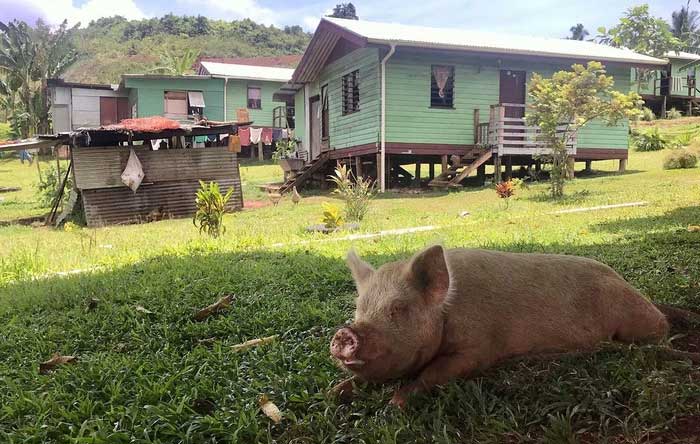
Vunidogoloa town in Fiji.
Dozens of coastal communities in Fiji have been planned for relocation to higher ground by the government, as the risk of being wiped out by rising sea levels looms closer than ever.
Among them is Vunidogoloa, a small village in Vanua Levu, the country’s second-largest island, which was the first village to be relocated to hillside areas in 2014.
However, today, the village that once housed over 150 residents has become a desolate place. The ruins are now covered by a vast expanse of vegetation.
Isle de Jean Charles, Louisiana
Communities along the Louisiana coastline have been heavily devastated by the impacts of rising sea levels, coastal erosion, storms, and hurricanes caused by climate change.
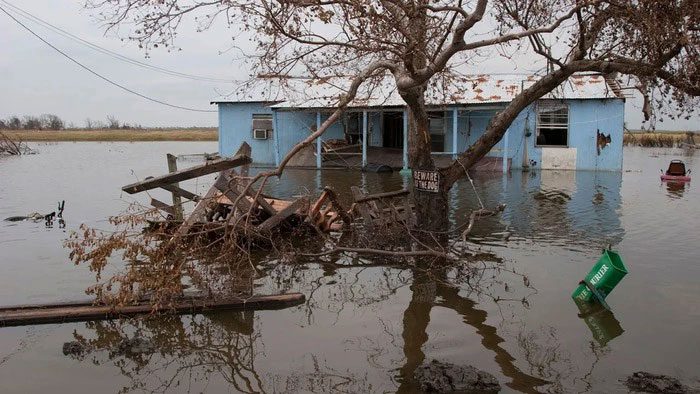
Isle de Jean Charles, in Terrebonne, Louisiana (USA), is gradually “disappearing”.
This includes Isle de Jean Charles, an island in the Gulf of Mexico located about 129 km south of New Orleans. Once covering nearly 9,000 hectares, today, the island is gradually sinking, with only about 129 hectares of land remaining.
The community here has received a government grant to develop a new settlement called “The New Isle,” located about 40 miles north of Isle de Jean Charles, on higher ground. As of October 2023, all residents of Isle de Jean Charles have relocated there, except for 4 households who chose to remain.
Cotul Morii, Moldova
Among the most vulnerable countries in Europe to climate change, Moldova faces numerous ongoing climate risks such as heatwaves, storms, droughts, and especially floods. This small country has recorded three major floods in the past 20 years.
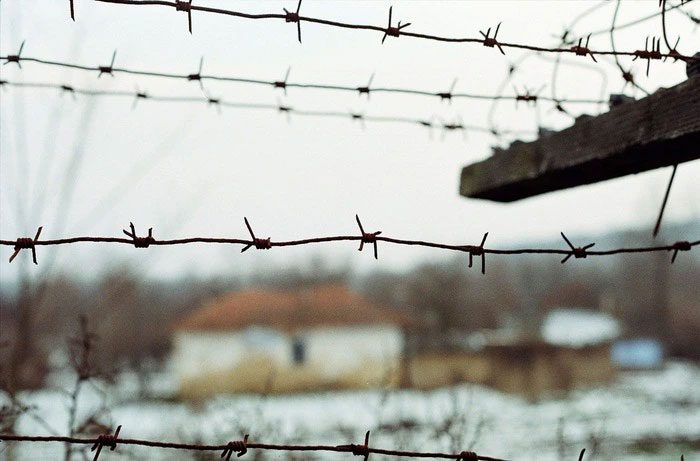
Cotul Morii, the village by the Prut River.
The impact of floods has caused severe damage to this country, where agriculture plays a significant role in the economy. Moreover, many inhabited areas are believed to be devastated beyond recovery. One such area is Cotul Morii, the village by the Prut River, which was submerged by a catastrophic flood in 2010.
Instead of restoring the population after the floods, the government opted to relocate Cotul Morii to an area about 9 miles away.
Chacaltaya Ski Resort, Bolivia
Opened in the 1930s, Chacaltaya Ski Resort is the only famous ski resort in the Andes of Bolivia and is considered the highest ski resort in the world, located atop Chacaltaya Mountain.
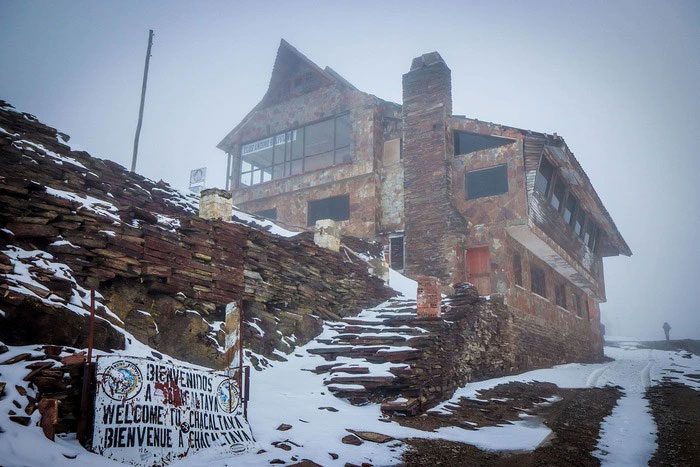
Chacaltaya ski resort.
For decades, Chacaltaya Ski Resort became a familiar destination for skiing enthusiasts until it had to close in 2009. That was also the year when the 18,000-year-old Chacaltaya glacier completely melted due to climate change. Along with it, a large portion of snow vanished entirely.
Today, the once-famous resort with its café, bar, and ski lifts has been abandoned, serving as a testament to what has occurred.
Valmeyer, Illinois (Chicago, USA)
Climate change has altered the drought and flood cycle along the Mississippi River, the longest river in North America, making weather forecasting challenging and inaccurate.
In 1993, a major flood inundated the small town of Valmeyer, Illinois—a state in the Chicago area—damaging most of the buildings there. The town’s residents, with government support, decided to rebuild their town in a neighboring area.
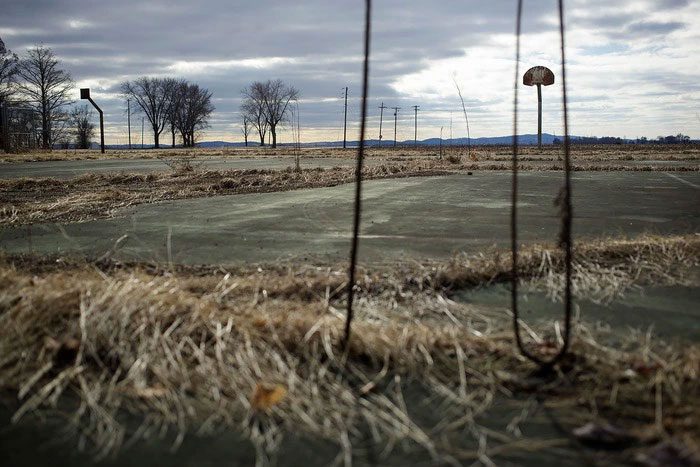
Old basketball court at the abandoned Valmeyer high school.
Although this flood event likely occurred before the visible impacts of climate change, 30 years later, Valmeyer is regarded as a prime example of a residential relocation strategy in response to increasingly harsh climate conditions.
“Dark Tourism” – A Tourism Solution to Raise Awareness and “Save” Ghost Lands
Developing “ghost towns” or abandoned villages into tourist attractions is a well-known method of economic recovery.
However, for lands devastated by natural disasters, no one wants to unexpectedly be evacuated during their holiday due to wildfires, storms, or floods.
<pAnd then, “necessity is the mother of invention”; people have thought of a method to develop “dark tourism.”
What is it?
Philip Stone, Director of the Dark Tourism Research Institute at the University of Central Lancashire, UK, explains that “dark” refers to the death, disaster, and haunting devastation of lands affected by natural disasters.
The purpose of this solution is to raise tourists’ awareness of the remnants of climate change through witnessing the lands that have been obliterated, to which we, humanity, have significantly contributed.
“The visual impact of landscapes devastated by climate change serves as a warning about our industrialization process,” Philip Stone stated. “Visiting such locations will provide an educational experience for tourists.”


















































